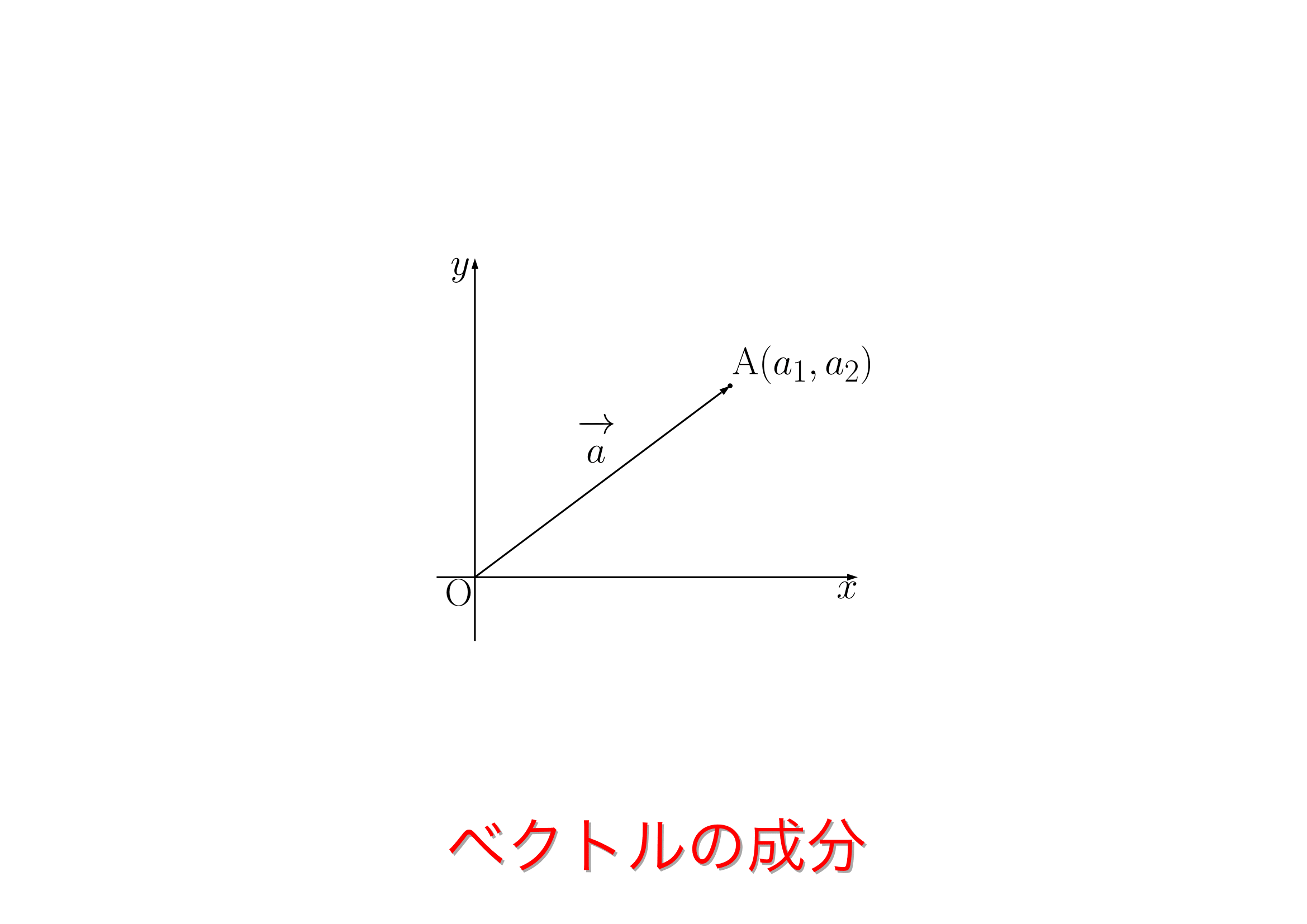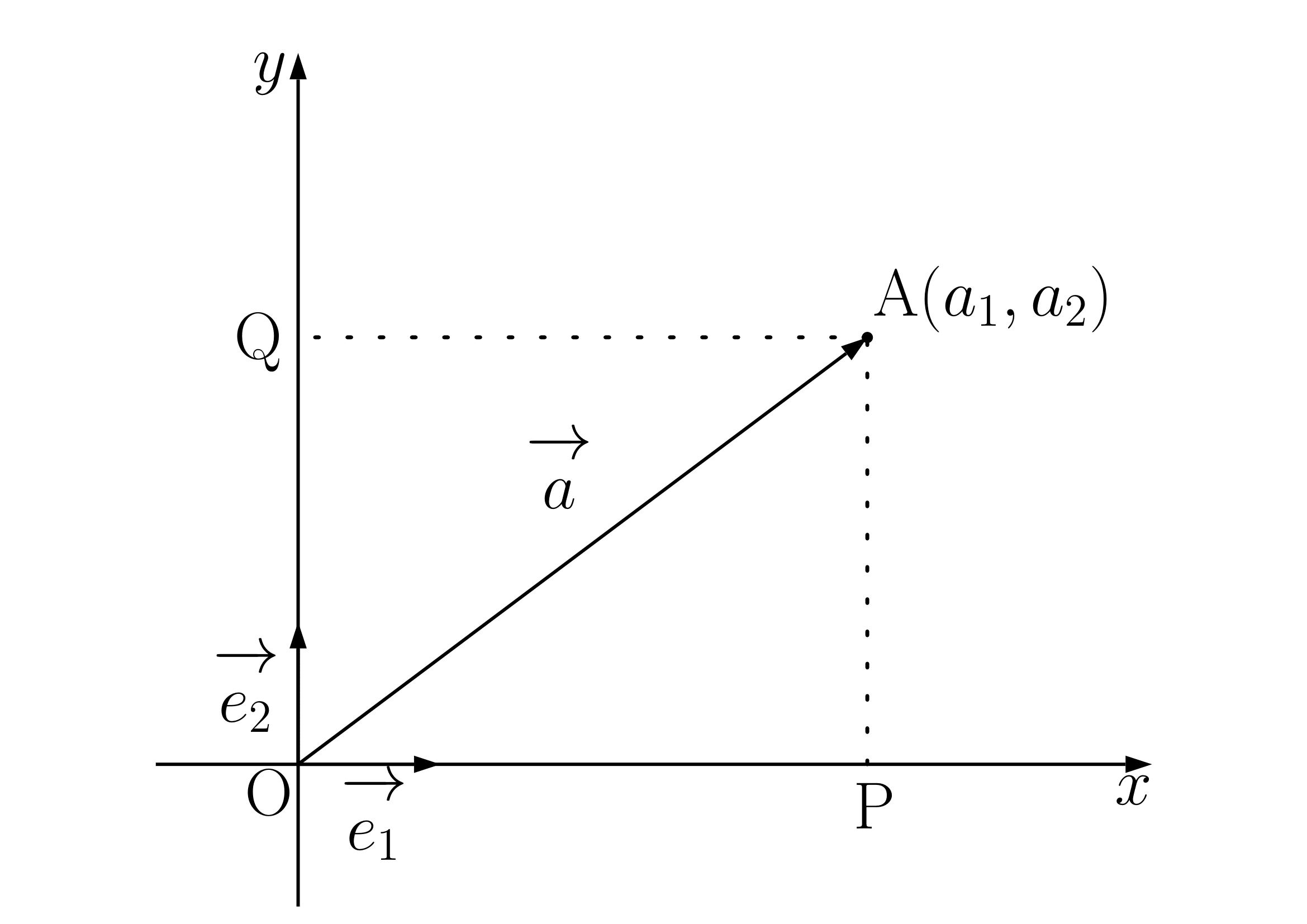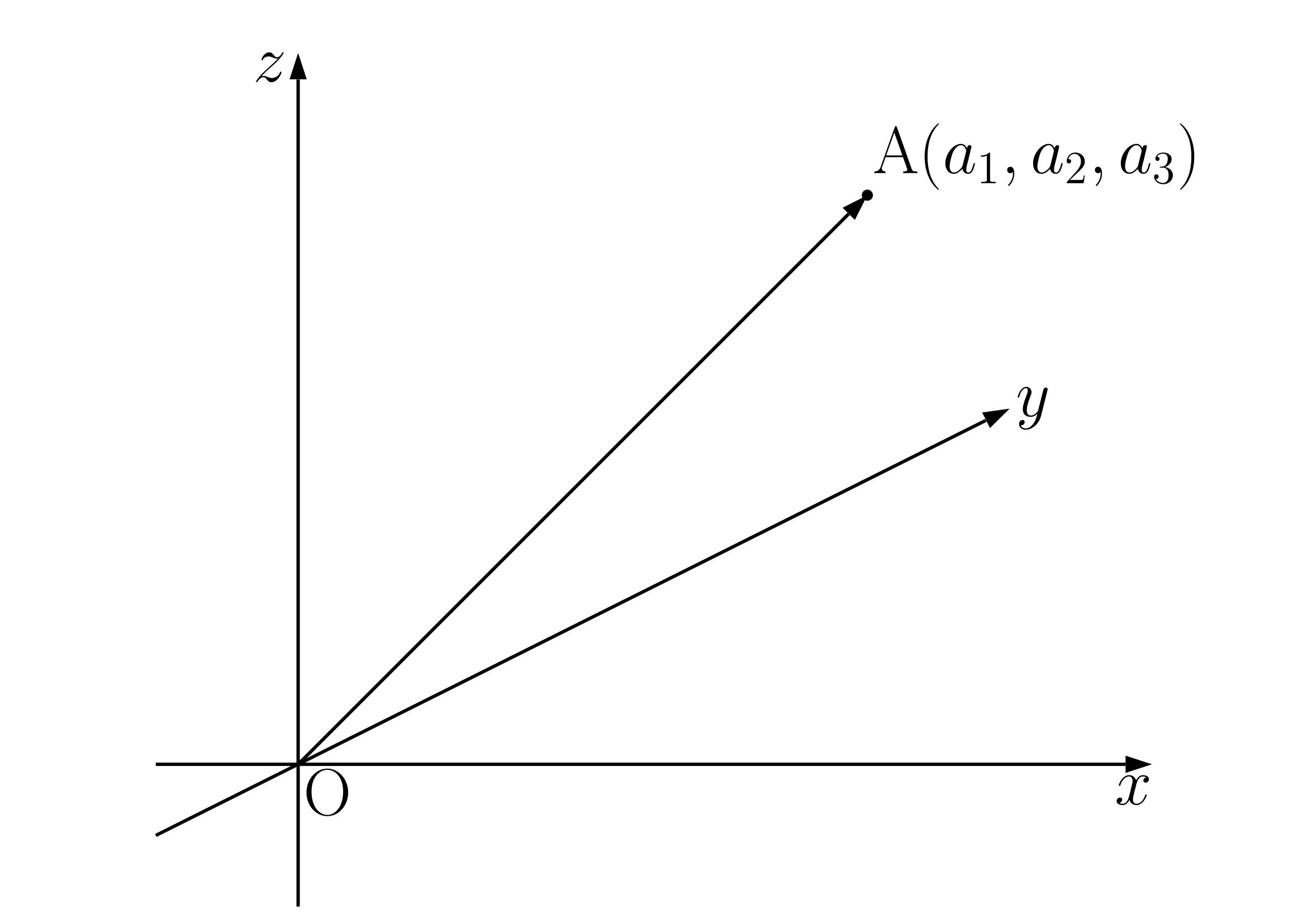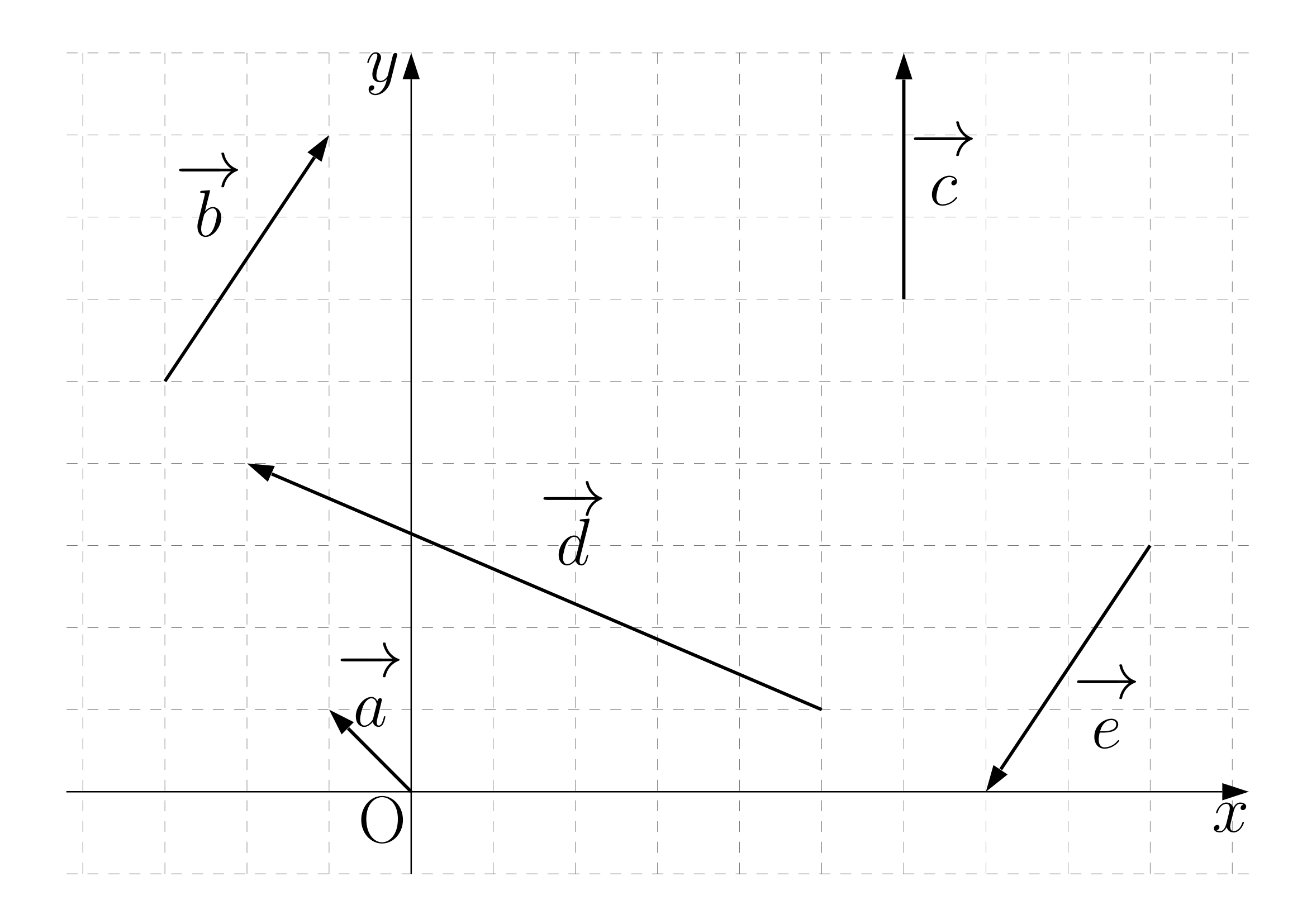ベクトルの成分
平面,空間ベクトル(教科書範囲) ★★

平面,空間ベクトル共通ページです.
ベクトルの成分について扱います.成分の導入,基本ベクトル,和,大きさ等一通り扱います.
平面ベクトル,空間ベクトルともに概念は同じです.平面ベクトル勉強中の場合は1章,3章のみご参照ください.
ベクトルの成分(平面ベクトル)
今までのベクトルの演算,ベクトルの分解では,図を書いて,場合によっては平行移動などもして和を求めたり分解したりしました.しかし毎回図を書くのは煩わしいので,機械的に計算する手段がほしいです.
ベクトルは平行移動しても同じという性質があるので,始点を原点にしたときの終点の座標でベクトルを表現します.
ベクトルの成分表示

$\overrightarrow{\mathstrut a}$ の始点を原点にしたとき,終点 $\rm A$ の座標を $(a_{1},a_{2})$ とすると,$\overrightarrow{\mathstrut a}$ を
$\boldsymbol{\overrightarrow{\mathstrut a}=(a_{1},a_{2})}$ または $\boldsymbol{\overrightarrow{\mathstrut a}=}\begin{pmatrix}\boldsymbol{a_{1}} \\ \boldsymbol{a_{2}} \end{pmatrix}$
と表す.$a_{1}$,$a_{2}$ をそれぞれ $x$ 成分,$y$ 成分という.
※ 右の表記の方が大学以降スタンダードですし,普通の座標と見間違えないので,当サイトでは右の表記を採用します.
※ 零ベクトルは $\overrightarrow{\mathstrut 0}=\begin{pmatrix}0 \\ 0\end{pmatrix}$ となります.
また,別の表現として基本ベクトルによる表現に言及します.今後証明などの用途で使います.
基本ベクトルによる表示

$\overrightarrow{\mathstrut e_{1}}=\begin{pmatrix}1 \\ 0\end{pmatrix}$,$\overrightarrow{\mathstrut e_{2}}=\begin{pmatrix}0 \\ 1\end{pmatrix}$ とし,これらを基本ベクトルという.$\overrightarrow{\mathstrut a}=\begin{pmatrix}a_{1} \\ a_{2}\end{pmatrix}$ は
$\boldsymbol{\overrightarrow{\mathstrut a}=a_{1}\overrightarrow{\mathstrut e_{1}}+a_{2}\overrightarrow{\mathstrut e_{2}}}$
と表せる.
※ 上の図から
$\overrightarrow{\mathstrut a}=\overrightarrow{\mathstrut \rm OA}=\overrightarrow{\mathstrut \rm OP}+\overrightarrow{\mathstrut \rm PA}=\overrightarrow{\mathstrut \rm OP}+\overrightarrow{\mathstrut \rm OQ}=a_{1}\overrightarrow{\mathstrut e_{1}}+a_{2}\overrightarrow{\mathstrut e_{2}}$
と導けますね.
これを使って成分によるベクトルの和,実数倍を導きます.
成分によるベクトルの和,実数倍
$\boldsymbol{\begin{pmatrix}\boldsymbol{a_{1}} \\ \boldsymbol{a_{2}}\end{pmatrix}+\begin{pmatrix}\boldsymbol{b_{1}} \\ \boldsymbol{b_{2}}\end{pmatrix}=\begin{pmatrix}\boldsymbol{a_{1}+b_{1}} \\ \boldsymbol{a_{2}+b_{2}}\end{pmatrix}}$
$\boldsymbol{\begin{pmatrix}\boldsymbol{a_{1}} \\ \boldsymbol{a_{2}}\end{pmatrix}-\begin{pmatrix}\boldsymbol{b_{1}} \\ \boldsymbol{b_{2}}\end{pmatrix}=\begin{pmatrix}\boldsymbol{a_{1}-b_{1}} \\ \boldsymbol{a_{2}-b_{2}}\end{pmatrix}}$
$\boldsymbol{k\begin{pmatrix}\boldsymbol{a_{1}} \\ \boldsymbol{a_{2}}\end{pmatrix}=\begin{pmatrix}\boldsymbol{ka_{1}} \\ \boldsymbol{ka_{2}}\end{pmatrix}}$
が成り立つ.
証明
$\begin{pmatrix}a_{1} \\ a_{2}\end{pmatrix}+\begin{pmatrix}b_{1} \\ b_{2}\end{pmatrix}$
$=a_{1}\overrightarrow{\mathstrut e_{1}}+a_{2}\overrightarrow{\mathstrut e_{2}}+b_{1}\overrightarrow{\mathstrut e_{1}}+b_{2}\overrightarrow{\mathstrut e_{2}}$
$=(a_{1}+b_{1})\overrightarrow{\mathstrut e_{1}}+(a_{2}+b_{2})\overrightarrow{\mathstrut e_{2}}$
$=\begin{pmatrix}a_{1}+b_{1} \\ a_{2}+b_{2}\end{pmatrix}$
$\begin{pmatrix}a_{1} \\ a_{2}\end{pmatrix}-\begin{pmatrix}b_{1} \\ b_{2}\end{pmatrix}$
$=a_{1}\overrightarrow{\mathstrut e_{1}}+a_{2}\overrightarrow{\mathstrut e_{2}}-(b_{1}\overrightarrow{\mathstrut e_{1}}+b_{2}\overrightarrow{\mathstrut e_{2}})$
$=(a_{1}-b_{1})\overrightarrow{\mathstrut e_{1}}+(a_{2}-b_{2})\overrightarrow{\mathstrut e_{2}}$
$=\begin{pmatrix}a_{1}-b_{1} \\ a_{2}-b_{2}\end{pmatrix}$
$k\begin{pmatrix}a_{1} \\ a_{2}\end{pmatrix}$
$=k(a_{1}\overrightarrow{\mathstrut e_{1}}+a_{2}\overrightarrow{\mathstrut e_{2}})$
$=(ka_{1})\overrightarrow{\mathstrut e_{1}}+(ka_{2})\overrightarrow{\mathstrut e_{2}}$
$=\begin{pmatrix}ka_{1} \\ ka_{2}\end{pmatrix}$
最後に,ベクトルの大きさを成分を利用して求める方法です.
ベクトルの大きさ
$\overrightarrow{\mathstrut a}=\begin{pmatrix}a_{1} \\ a_{2}\end{pmatrix}$ のとき
$\boldsymbol{|\overrightarrow{\mathstrut a}|=\sqrt{a_{1}^{2}+a_{2}^{2}}}$
※ 証明は三平方の定理から容易に導けますね.
ベクトルの成分(空間ベクトル)
空間ベクトルでも,前章と同様です.
ベクトルの成分表示

$\overrightarrow{\mathstrut a}$ の始点を原点にしたとき,終点 $\rm A$ の座標を $(a_{1},a_{2},a_{3})$ とすると,$\overrightarrow{\mathstrut a}$ は
$\boldsymbol{\overrightarrow{\mathstrut a}=(a_{1},a_{2},a_{3})}$ または $\boldsymbol{\overrightarrow{\mathstrut a}=}\begin{pmatrix}\boldsymbol{a_{1}} \\ \boldsymbol{a_{2}} \\ a_{3}\end{pmatrix}$
と表す.$a_{1}$,$a_{2}$,$a_{3}$ をそれぞれ $x$ 成分,$y$ 成分,$z$ 成分という.
※ 右の表記の方が大学以降スタンダードですし,普通の座標と見間違えないので,当サイトでは右の表記を採用します.
※ 零ベクトルは $\overrightarrow{\mathstrut 0}=\begin{pmatrix}0 \\ 0 \\ 0\end{pmatrix}$ となります.
空間でも基本ベクトルによる表現に言及します.
基本ベクトルによる表示
$\overrightarrow{\mathstrut e_{1}}=\begin{pmatrix}1 \\ 0 \\ 0\end{pmatrix}$,$\overrightarrow{\mathstrut e_{2}}=\begin{pmatrix}0 \\ 1 \\ 0\end{pmatrix}$,$\overrightarrow{\mathstrut e_{3}}=\begin{pmatrix}0 \\ 0 \\ 1\end{pmatrix}$ とし,これらを基本ベクトルという.$\overrightarrow{\mathstrut a}=\begin{pmatrix}a_{1} \\ a_{2} \\ a_{3}\end{pmatrix}$ は
$\boldsymbol{\overrightarrow{\mathstrut a}=a_{1}\overrightarrow{\mathstrut e_{1}}+a_{2}\overrightarrow{\mathstrut e_{2}}+a_{3}\overrightarrow{\mathstrut e_{3}}}$
と表せる.
これを使って成分によるベクトルの和,実数倍を導きます.
成分によるベクトルの和,実数倍
$\boldsymbol{\begin{pmatrix}\boldsymbol{a_{1}} \\ \boldsymbol{a_{2}} \\ \boldsymbol{a_{3}}\end{pmatrix}+\begin{pmatrix}\boldsymbol{b_{1}} \\ \boldsymbol{b_{2}} \\ \boldsymbol{b_{3}}\end{pmatrix}=\begin{pmatrix}\boldsymbol{a_{1}+b_{1}} \\ \boldsymbol{a_{2}+b_{2}} \\ \boldsymbol{a_{3}+b_{3}}\end{pmatrix}}$
$\boldsymbol{\begin{pmatrix}\boldsymbol{a_{1}} \\ \boldsymbol{a_{2}} \\ \boldsymbol{a_{3}}\end{pmatrix}-\begin{pmatrix}\boldsymbol{b_{1}} \\ \boldsymbol{b_{2}} \\ \boldsymbol{b_{3}}\end{pmatrix}=\begin{pmatrix}\boldsymbol{a_{1}-b_{1}} \\ \boldsymbol{a_{2}-b_{2}} \\ \boldsymbol{a_{3}-b_{3}}\end{pmatrix}}$
$\boldsymbol{k\begin{pmatrix}\boldsymbol{a_{1}} \\ \boldsymbol{a_{2}} \\ \boldsymbol{a_{3}}\end{pmatrix}=\begin{pmatrix}\boldsymbol{ka_{1}} \\ \boldsymbol{ka_{2}} \\ \boldsymbol{ka_{3}}\end{pmatrix}}$
が成り立つ.
証明
$\begin{pmatrix}a_{1} \\ a_{2} \\ a_{3}\end{pmatrix}+\begin{pmatrix}b_{1} \\ b_{2} \\ b_{3}\end{pmatrix}$
$=a_{1}\overrightarrow{\mathstrut e_{1}}+a_{2}\overrightarrow{\mathstrut e_{2}}+a_{3}\overrightarrow{\mathstrut e_{3}}+b_{1}\overrightarrow{\mathstrut e_{1}}+b_{2}\overrightarrow{\mathstrut e_{2}}+b_{3}\overrightarrow{\mathstrut e_{3}}$
$=(a_{1}+b_{1})\overrightarrow{\mathstrut e_{1}}+(a_{2}+b_{2})\overrightarrow{\mathstrut e_{2}}+(a_{3}+b_{3})\overrightarrow{\mathstrut e_{3}}$
$=\begin{pmatrix}a_{1}+b_{1} \\ a_{2}+b_{2} \\ a_{3}+b_{3}\end{pmatrix}$
$\begin{pmatrix}a_{1} \\ a_{2} \\ a_{3}\end{pmatrix}-\begin{pmatrix}b_{1} \\ b_{2} \\ b_{3}\end{pmatrix}$
$=a_{1}\overrightarrow{\mathstrut e_{1}}+a_{2}\overrightarrow{\mathstrut e_{2}}+a_{3}\overrightarrow{\mathstrut e_{3}}-(b_{1}\overrightarrow{\mathstrut e_{1}}+b_{2}\overrightarrow{\mathstrut e_{2}}+b_{3}\overrightarrow{\mathstrut e_{3}})$
$=(a_{1}-b_{1})\overrightarrow{\mathstrut e_{1}}+(a_{2}-b_{2})\overrightarrow{\mathstrut e_{2}}+(a_{3}-b_{3})\overrightarrow{\mathstrut e_{3}}$
$=\begin{pmatrix}a_{1}-b_{1} \\ a_{2}-b_{2} \\ a_{3}-b_{3}\end{pmatrix}$
$k\begin{pmatrix}a_{1} \\ a_{2} \\ a_{3}\end{pmatrix}$
$=k(a_{1}\overrightarrow{\mathstrut e_{1}}+a_{2}\overrightarrow{\mathstrut e_{2}}+a_{3}\overrightarrow{\mathstrut e_{3}})$
$=(ka_{1})\overrightarrow{\mathstrut e_{1}}+(ka_{2})\overrightarrow{\mathstrut e_{2}}+(ka_{3})\overrightarrow{\mathstrut e_{3}}$
$=\begin{pmatrix}ka_{1} \\ ka_{2} \\ ka_{3}\end{pmatrix}$
最後に,ベクトルの大きさを成分を利用して求める方法です.
ベクトルの大きさ
$\overrightarrow{\mathstrut a}=\begin{pmatrix}a_{1} \\ a_{2} \\ a_{3}\end{pmatrix}$ のとき
$\boldsymbol{|\overrightarrow{\mathstrut a}|=\sqrt{a_{1}^{2}+a_{2}^{2}+a_{3}^{2}}}$
※ 証明は $\rm O(0,0,0)$ と $(a_{1},a_{2},a_{3})$ の2点間の距離と同じです.
例題と練習問題(平面ベクトル)
例題
例題
(1)下の図で,$\overrightarrow{\mathstrut a}$,$\overrightarrow{\mathstrut b}$,$\overrightarrow{\mathstrut c}$,$\overrightarrow{\mathstrut d}$,$\overrightarrow{\mathstrut e}$ の成分表示と大きさをそれぞれ求めよ.

(2) $\overrightarrow{\mathstrut a}=\begin{pmatrix}-2 \\ 3\end{pmatrix}$,$\overrightarrow{\mathstrut b}=\begin{pmatrix}1 \\ -9\end{pmatrix}$ のとき,$\overrightarrow{\mathstrut c}=3\overrightarrow{\mathstrut a}+2\overrightarrow{\mathstrut a}$ を求めよ.
(3) $\overrightarrow{\mathstrut a}=\begin{pmatrix}4 \\ 2\end{pmatrix}$,$\overrightarrow{\mathstrut b}=\begin{pmatrix}1 \\ 3\end{pmatrix}$,$\overrightarrow{\mathstrut c}=\begin{pmatrix}11 \\ 13\end{pmatrix}$ のとき,$\overrightarrow{\mathstrut c}=s\overrightarrow{\mathstrut a}+t\overrightarrow{\mathstrut b}$ となる $s$ と $t$ の値を求めよ.
(4) $\rm A(1,-2)$,$\rm B(5,7)$ があるとき,$\overrightarrow{\mathstrut \rm AB}$ を成分で表せ.
講義
(1)では終点に向かって増えた $x$ 成分,$y$ 成分に注目して成分表示するといいと思います.
(4)ではベクトルの分解公式
$\boldsymbol{\overrightarrow{\mathstrut \rm AB}=\overrightarrow{\mathstrut \rm □B}-\overrightarrow{\mathstrut \rm □A}}$
を使って始点を原点から始まるベクトルに変形します.
解答
(1)
$\overrightarrow{\mathstrut a}=\boldsymbol{\begin{pmatrix}\boldsymbol{-1} \\ \boldsymbol{1}\end{pmatrix}}$ $|\overrightarrow{\mathstrut a}|=\sqrt{(-1)^{2}+1^2}=\boldsymbol{\sqrt{2}}$
$\overrightarrow{\mathstrut b}=\boldsymbol{\begin{pmatrix}\boldsymbol{2} \\ \boldsymbol{3}\end{pmatrix}}$ $|\overrightarrow{\mathstrut b}|=\sqrt{2^{2}+3^2}=\boldsymbol{\sqrt{13}}$
$\overrightarrow{\mathstrut c}=\boldsymbol{\begin{pmatrix}\boldsymbol{0} \\ \boldsymbol{3}\end{pmatrix}}$ $|\overrightarrow{\mathstrut c}|=\boldsymbol{3}$
$\overrightarrow{\mathstrut d}=\boldsymbol{\begin{pmatrix}\boldsymbol{-7} \\ \boldsymbol{3}\end{pmatrix}}$ $|\overrightarrow{\mathstrut d}|=\sqrt{(-7)^{2}+3^2}=\boldsymbol{\sqrt{58}}$
$\overrightarrow{\mathstrut e}=\boldsymbol{\begin{pmatrix}\boldsymbol{-2} \\ \boldsymbol{-3}\end{pmatrix}}$ $|\overrightarrow{\mathstrut e}|=\sqrt{(-2)^{2}+(-3)^2}=\boldsymbol{\sqrt{13}}$
(2)
$\overrightarrow{\mathstrut c}$
$=3\begin{pmatrix}-2 \\ 3\end{pmatrix}+2\begin{pmatrix}1 \\ -9\end{pmatrix}$
$=\begin{pmatrix}-6 \\ 9\end{pmatrix}+\begin{pmatrix}2 \\ -18\end{pmatrix}$
$=\boldsymbol{\begin{pmatrix}\boldsymbol{-4} \\ \boldsymbol{-9}\end{pmatrix}}$
(3)
$\begin{pmatrix}11 \\ 13\end{pmatrix}=s\begin{pmatrix}4 \\ 2\end{pmatrix}+t\begin{pmatrix}1 \\ 3\end{pmatrix}=\begin{pmatrix}4s+t \\ 2s+3t \end{pmatrix}$
$x$,$y$ 成分それぞれ比較すると
$\begin{cases}4s+t=11 \\ 2s+3t=13\end{cases}$
解くと $\boldsymbol{s=2,t=3}$
(4)
$\overrightarrow{\mathstrut \rm AB}$
$=\overrightarrow{\mathstrut \rm OB}-\overrightarrow{\mathstrut \rm OA}$ ←原点から始めるベクトルに
$=\begin{pmatrix}5 \\ 7\end{pmatrix}-\begin{pmatrix}1 \\ -2\end{pmatrix}$
$=\boldsymbol{\begin{pmatrix}\boldsymbol{4} \\ \boldsymbol{9}\end{pmatrix}}$
練習問題
練習1
$\rm A(-2,-2)$,$\rm B(2,1)$,$\rm C(0,3)$ がある.
(1) $\overrightarrow{\mathstrut \rm AB}$ を成分で表し,大きさも求めよ.
(2) 四角形 $\rm ABCD$ が平行四辺形となるとき,$\rm D$ の座標を求めよ.
(3) 3点 $\rm A$,$\rm B$,${\rm X}(t,t-3)$ が一直線上にあるように,定数 $t$ の値を求めよ.
練習2
$t$ は実数とする.$\overrightarrow{\mathstrut a}=\begin{pmatrix}-1 \\ 2\end{pmatrix}$,$\overrightarrow{\mathstrut d}=\begin{pmatrix}1 \\ 1\end{pmatrix}$,$|\overrightarrow{\mathstrut a}+t\overrightarrow{\mathstrut d}|$ を最小にする $t$ の値を求めよ.
練習1の解答
(1)
$\overrightarrow{\mathstrut \rm AB}$
$=\overrightarrow{\mathstrut \rm OB}-\overrightarrow{\mathstrut \rm OA}$
$=\begin{pmatrix}2 \\ 1\end{pmatrix}-\begin{pmatrix}-2 \\ -2\end{pmatrix}$
$=\boldsymbol{\begin{pmatrix}\boldsymbol{4} \\ \boldsymbol{3}\end{pmatrix}}$
$|\overrightarrow{\mathstrut \rm AB}|=\sqrt{4^{2}+3^{2}}=\boldsymbol{5}$
(2)

${\rm D}(x,y)$ とおく.$\overrightarrow{\mathstrut \rm AB}=\overrightarrow{\mathstrut \rm DC}$ より
$\begin{pmatrix}4 \\ 3\end{pmatrix}=\begin{pmatrix}-x \\ 3-y\end{pmatrix}$
解くと $x=-4,y=0$.$\boldsymbol{{\rm D}(-4,0)}$
(3)
$\overrightarrow{\mathstrut \rm AX}$
$=\overrightarrow{\mathstrut \rm OX}-\overrightarrow{\mathstrut \rm OA}$
$=\begin{pmatrix}t+2 \\ t-1\end{pmatrix}$
$\overrightarrow{\mathstrut \rm AX}=k\overrightarrow{\mathstrut \rm AB}$ とおけるので
$\begin{pmatrix}t+2 \\ t-1\end{pmatrix}=\begin{pmatrix}4k \\ 3k\end{pmatrix}$
比較して解くと,$k=3$,$\boldsymbol{t=10}$.
練習2の解答
$|\overrightarrow{\mathstrut a}+t\overrightarrow{\mathstrut d}|$
$=\left|\begin{pmatrix}t-1 \\ t+2\end{pmatrix}\right|$
$=\sqrt{(t-1)^{2}+(t+2)^{2}}$
$=\sqrt{2t^{2}+2t+5}$
$=\sqrt{2\left(t+\dfrac{1}{2}\right)^{2}+\dfrac{9}{2}}$
$\boldsymbol{t=-\dfrac{1}{2}}$ のとき,最小値 $\sqrt{\dfrac{9}{2}}=\boldsymbol{\dfrac{3}{\sqrt{2}}}$
※ 余談ですが,直線の媒介変数表示の知識があれば,$\overrightarrow{\mathstrut a}+t\overrightarrow{\mathstrut d}$ は $(-1,2)$ を通る方向ベクトルが $\begin{pmatrix}1 \\ 1\end{pmatrix}$ の直線(つまり $y=x+3$ )です.$|\overrightarrow{\mathstrut a}+t\overrightarrow{\mathstrut d}|$ は原点とこの直線上の動点の2点間の距離であるとわかります.最小値だけなら点と直線の距離でも求められますね.
例題と練習問題(空間ベクトル)
例題
例題
(1) $\overrightarrow{\mathstrut a}=\begin{pmatrix}1 \\ 0 \\ -3\end{pmatrix}$,$\overrightarrow{\mathstrut b}=\begin{pmatrix}-1 \\ 0 \\ 1\end{pmatrix}$,$\overrightarrow{\mathstrut c}=\begin{pmatrix}2 \\ 1 \\ 0\end{pmatrix}$ のとき,$\overrightarrow{\mathstrut p}=\begin{pmatrix}12 \\ 7 \\ 0\end{pmatrix}$ を $s\overrightarrow{\mathstrut a}+t\overrightarrow{\mathstrut b}+u\overrightarrow{\mathstrut c}$ の形に表せ.
(2) $\rm A(3,1,0)$,$\rm B(-4,1,3)$ があるとき,$\overrightarrow{\mathstrut \rm AB}$ を成分で表せ.また,大きさを求めよ.
講義
本質的に平面と同様で,ただ $z$ 成分が増えただけです.空間は全体的に計算量が多くなります.
解答
(1)
$\begin{pmatrix}12 \\ 7 \\ 0\end{pmatrix}=s\begin{pmatrix}1 \\ 0 \\ -3\end{pmatrix}+t\begin{pmatrix}-1 \\ 0 \\ 1\end{pmatrix}+u\begin{pmatrix}2 \\ 1 \\ 0\end{pmatrix}=\begin{pmatrix}s-t+2u \\ u \\ -3s+t\end{pmatrix}$
$x$,$y$,$z$ 成分それぞれ比較すると
$\begin{cases}s-t+2u=12 \\ u=7 \\ -3s+t=0\end{cases}$
解くと $s=1,t=3,u=7$.つまり $\boldsymbol{\overrightarrow{\mathstrut p}=\overrightarrow{\mathstrut a}+3\overrightarrow{\mathstrut b}+7\overrightarrow{\mathstrut c}}$
(2)
$\overrightarrow{\mathstrut \rm AB}$
$=\overrightarrow{\mathstrut \rm OB}-\overrightarrow{\mathstrut \rm OA}$ ←原点から始めるベクトルに
$=\begin{pmatrix}3 \\ 1 \\ 0\end{pmatrix}-\begin{pmatrix}-4 \\ 1 \\ 3\end{pmatrix}$
$=\boldsymbol{\begin{pmatrix}\boldsymbol{7} \\ \boldsymbol{0}\\ \boldsymbol{-3}\end{pmatrix}}$
$|\overrightarrow{\mathstrut \rm AB}|=\sqrt{7^{2}+0^{2}+(-3)^{2}}=\boldsymbol{\sqrt{58}}$
練習問題
練習1
$\rm A(-1,-2,5)$,$\rm B(2,1,-4)$,$\rm C(1,3,0)$ がある.四角形 $\rm ABCD$ が平行四辺形となるとき,$\rm D$ の座標を求めよ.
練習2
$t$ は実数とする.$\overrightarrow{\mathstrut a}=\begin{pmatrix}-1 \\ 2 \\ 3\end{pmatrix}$,$\overrightarrow{\mathstrut d}=\begin{pmatrix}1 \\ 0 \\ -1\end{pmatrix}$,$|\overrightarrow{\mathstrut a}+t\overrightarrow{\mathstrut d}|$ を最小にする $t$ の値を求めよ.
練習1の解答

${\rm D}(x,y,z)$ とおく.$\overrightarrow{\mathstrut \rm AB}=\overrightarrow{\mathstrut \rm DC}$ より
$\begin{pmatrix}3 \\ 3 \\ -9\end{pmatrix}=\begin{pmatrix}1-x \\ 3-y \\ -z\end{pmatrix}$
解くと $x=-2,y=0,z=9$.$\boldsymbol{{\rm D}(-2,0,9)}$
練習2の解答
$|\overrightarrow{\mathstrut a}+t\overrightarrow{\mathstrut d}|$
$=\left|\begin{pmatrix}t-1 \\ 2 \\ -t+3\end{pmatrix}\right|$
$=\sqrt{(t-1)^{2}+2^{2}+(-t+3)^{2}}$
$=\sqrt{2t^{2}-8t+14}$
$=\sqrt{2\left(t-2\right)^{2}+6}$
$\boldsymbol{t=2}$ のとき,最小値 $\boldsymbol{\sqrt{6}}$
※ 直線の媒介変数表示の知識があれば,$\overrightarrow{\mathstrut a}+t\overrightarrow{\mathstrut d}$ は $(-1,2,3)$ を通る方向ベクトルが $\begin{pmatrix}1 \\ 0 \\ -1\end{pmatrix}$ の直線です.$|\overrightarrow{\mathstrut a}+t\overrightarrow{\mathstrut d}|$ は原点とこの直線上の動点の2点間の距離であるとわかります.
